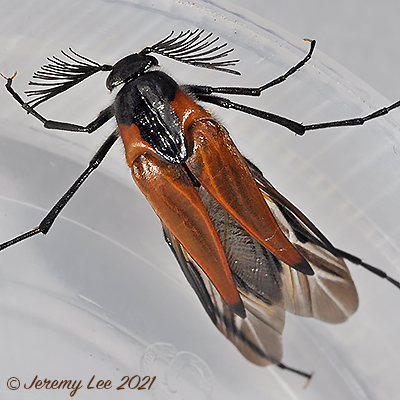
 |
|
Scientific Classifications explained » Amphibians » Ants » Aphids » Bees » Beetles » Birds » Bugs » Butterflies » Caterpillars » Damselflies » Dragonflies » Earwigs » Flies » Frog/Leafhoppers » Fungi » Galls » Grasshoppers » Harvestmen » Hoverflies » Lacewings » Ladybirds » Leaf Mines » Lichens » Mammals » Millipedes » Mosses » Moths » Sawflies » Slugs » Snails » Spiders » Trees & Shrubs » Wasps » Wild Flowers » Woodlice » Postboxes |
UK Nature > Beetles > Metoecus paradoxus

Scientific Name: Metoecus paradoxus Common Name: Wasp Nest Beetle Metoecus paradoxus, more commonly known as the Wasp Nest Beetle, is is a rather odd-looking, almost fly-like, insect about 10 mm long with narrow pointed elytra which do not completely cover the wings or abdomen. It has feathery antennae and is a parasite of wasps' nests, hence its common name. Normally associated with underground wasps' nests but several have been found emerging from wasps' nests in house roof spaces. The adults emerge during the summer months. This species has a fascinating life history which was only worked out in Victorian times. The adult lays eggs on rotting wood in the hope that a wasp will visit to harvest wood fibre for its nest. If one does, the beetle larva tries to climb onto the back of the wasp and is transported to the nest. It then seeks out a wasp grub and parasitises it. The beetle grows and pupates and emerges as an adult just after the time the wasp would have done. This species is widespread but not common in Britain. |
|

https://www.uknature.co.uk is a website dedicated to showing the immense diversity of UK nature and wildlife. Our vast range of habitats, from lowland arable to snow covered mountains, from storm-ravaged coastlines to peaceful inland freshwater lakes and rivers, from dry, sandy heaths to deciduous and coniferous forests, all these habitats contribute to the abundance of UK nature. We have wild birds in huge numbers either residing or visiting our shores (597 recorded species as at July 2013) and we must also not forget the humble back garden with its grass lawns, flower beds filled with nectar rich flowers, shrubs and trees, all designed to attract huge numbers of insects such as bees, moths, butterflies and hoverflies; and finally the small ponds which provide safe havens for frogs, toads, newts and even slow worms and grass snakes. www.uknature.co.uk is the showcase for my personal passion, photographing uknature in all its glory. I sincerely hope you all enjoy the fruits of my labours. This site and all images contained therein is © Jeremy Lee 2004 - 2025. All Rights Reserved. Site design by Jeremy Lee. Site development & IT Support by Stuart Lee. |